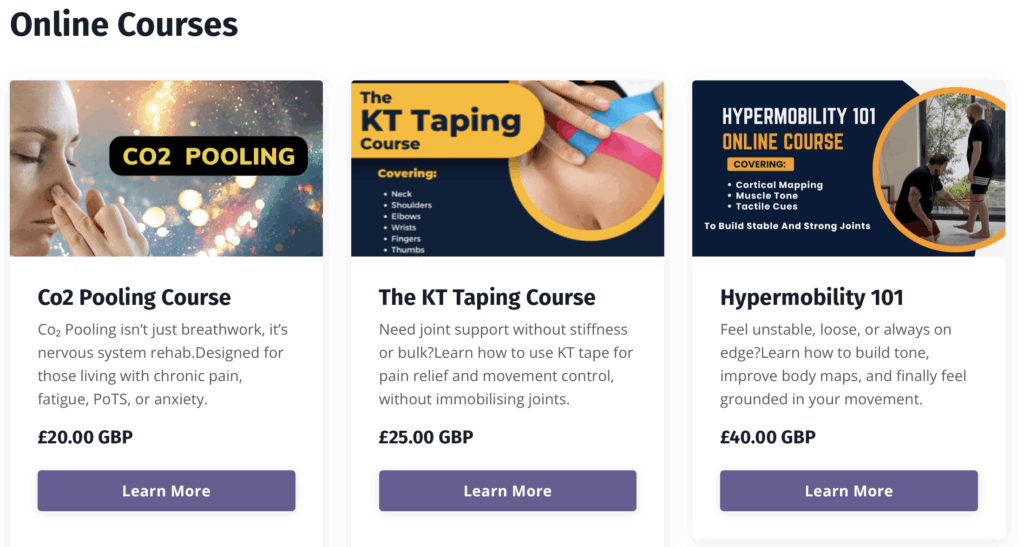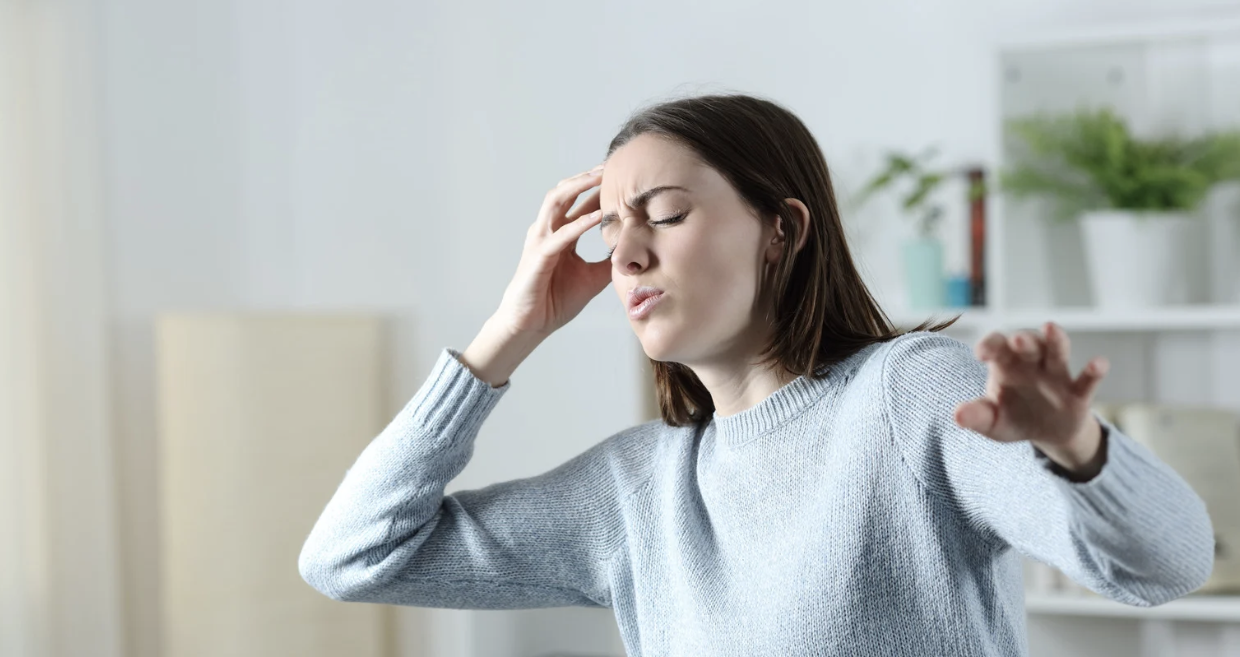- POTS and Exercise: The First Step Everyone Misses - 27 June 2025
- The Missing Link Between Breathlessness, Fatigue, and Chronic Pain: Understanding CO₂ Tolerance - 19 June 2025
- What is Mast Cell Activation Syndrome? - 12 May 2025
If you’ve been living with POTS for any length of time, you’ve probably become an unwilling expert in unpredictability. One day you might be able to potter around the house or even manage a light walk, and the next you find yourself flattened by a kind of exhaustion that seems to seep into every cell. It’s the kind of fatigue that doesn’t lift with rest and can’t be explained away by simply doing too much.
And if you’ve ever felt like your symptoms don’t quite make sense, or that no one seems to be connecting the dots between your breathlessness, brain fog, pounding heart, and relentless fatigue, then you’re far from alone. Because as strange as it might sound, there’s a growing body of research that suggests these symptoms may not be as separate as they seem.
More and more, researchers are uncovering a quiet but powerful driver behind many of the most debilitating symptoms seen in POTS. It’s not something that shows up in a standard blood test or gets much attention in the average clinical setting. But for up to half of all people with POTS, it may be playing a central role in everything from exercise intolerance and poor sleep, to gastrointestinal issues and cognitive dysfunction (1).
Over the years, we have seen a consistent pattern in the people who come through our doors. The majority of our hypermobile clients also experience symptoms of POTS, and often they have already been formally diagnosed. We have been working with this combination since 2009, and throughout that time, one specific issue has continued to stand out as a foundation for progress. That issue is carbon dioxide tolerance.
What we have found is that many of our clients have developed a reduced tolerance to carbon dioxide. Their systems react too quickly and too strongly to even small increases in CO₂, often without them noticing. This is not because they are breathing incorrectly in a conscious way, but because their nervous system has become conditioned to feel unsafe as CO₂ rises, very often from infections and other things such as covid (actually, since 2020, there has been a sharp up take in POTS clients for us), This aligns with research showing a dramatic increase in POTS incidence following the COVID-19 pandemic, with rates increasing from 1.42 per 1 million person-years before COVID to 20.3 cases per 1 million person-years after COVID (2) (3). This leads to patterns of over-breathing that may not look dramatic from the outside, but which silently alter the body’s internal chemistry in ways that have very real consequences.
When CO₂ levels are too low, oxygen becomes harder to access at the tissue level (4) (5), blood flow to the brain becomes restricted, and the nervous system begins to spiral into a state of threat, and as time goes on, staying in this state creates dysfunction in the nervous system, as you’re not supposed to be in this side of your nervous system all day long (6) (7). This state not only affects energy levels and cognitive function, but it also makes it incredibly difficult to tolerate movement or recover from even small amounts of physical effort.
This is why we place such a strong emphasis on CO₂ pooling. When clients can safely increase their tolerance to carbon dioxide, the body becomes more stable, oxygen delivery improves, and exercise becomes something that can finally be reintroduced without triggering a crash. Once that window opens, we can start to focus on what truly matters for long-term recovery, building joint control, improving proprioception, and creating a nervous system that feels safe enough to support change.
So, in this blog, we are going to look more closely at what hypocapnia is, how it links together so many of the symptoms seen in POTS, and why improving CO₂ tolerance may be one of the most important steps you can take before even thinking about formal exercise.
This article covers:
ToggleWhat Is Hypocapnia, and Why Does It Matter?
One of the most common things we hear from clients with POTS is that they have already been through every protocol under the sun. They have tried the salt, the fluids, the compression garments, the pacing, and of course, the exercise plans that are almost always centred around cardio.
Most of them are told that their biggest issue is deconditioning, and that the answer lies in doing more upright aerobic work to rebuild their tolerance. Which, if I’m frank, really rubs me the wrong way. You don’t have pots because your deconditioned, you are deconditioned because you have POTS, you can’t just reverse your way out of it.
But what often gets missed is the reason why the body became deconditioned in the first place. Because when someone with POTS stands up and starts moving, the issue is not simply that they are unfit. The issue is that their body is unable to deliver oxygen properly, unable to regulate blood flow to the brain, and unable to maintain balance within the nervous system(8). In that kind of environment, asking someone to push through cardio is not just ineffective, it can make things worse.
It’s the same as forcing anyone from the healthy population to go running, but only letting them breathe for 10 seconds, every 20 seconds, eventually they are going to crash. And it’s no different for those with POTS trying to exercise, the body simply cannot function well enough to extract oxygen to do the job, there’s also the little issue of how low Co2 affects mitochondria, but that’s getting a little ahead of ourselves for now.
In studio, we regularly see clients who have been through structured POTS protocols and made very little progress. They follow the plans, they push themselves, and yet they keep crashing. The fatigue never improves, the dizziness persists, and every attempt at building strength seems to backfire. They are told to exercise because they are deconditioned, but no one stops to ask whether their body is even capable of handling that demand yet. And without understanding what is happening at a chemical level, it is easy to think the problem is just a lack of effort, which is likely why those with POTs frequently tell us of medical gaslighting horror stories.
This is where hypocapnia becomes such a key piece of the puzzle. Hypocapnia refers to a state where carbon dioxide levels in the blood fall too low, often due to breathing that is just slightly deeper or more frequent than the body actually needs. Most people with hypocapnia are not gasping or hyperventilating in a dramatic way. Instead, their breathing pattern becomes subtly disrupted, usually without them noticing, especially when upright or under stress.
But this small change in breathing can create big problems. Low CO₂ reduces blood flow to the brain by causing vasoconstriction (5) (say hello to brain fog). It makes it harder for oxygen to be released from the blood into the tissues, which means the muscles do not get the fuel they need. It sends the nervous system into a state of increased alertness, where everything starts to feel harder, and the body begins to compensate by increasing heart rate. And it puts pressure on the mitochondria, which are already struggling to produce enough energy (9). Research has consistently shown that hypocapnia independently increases heart rate in POTS patients – in one study, heart rate was significantly greater during hypocapnia versus eucapnia (99±12 bpm vs 82±10 bpm).
This is why traditional exercise protocols often fail for people with POTS. They are being asked to increase their physical output before the body has been given the tools to tolerate movement in the first place. The result is not just poor progress but a deep sense of frustration and self-doubt. Clients begin to wonder if they are doing something wrong, when in reality, the problem is that their physiology is not being supported in the way it needs. Research supports this: in community-based exercise programs for POTS, only 41% of patients complete the program, meaning approximately 59% of patients are unable to finish traditional exercise interventions.
What we have found, in over a decade of working with these clients, is that when we first address the underlying low tolerance to blood Co2, by improving carbon dioxide tolerance, the entire system becomes more stable. Breathing begins to calm, oxygen delivery improves, and movement stops feeling so threatening. That is when we can start to build real strength, not just in the muscles and joints, but within the nervous system as a whole.
The First Stop Before Exercising with Postural tachycardia syndrome (PoTS)
Before you even start thinking about exercise, there is one step that absolutely needs to come first. It is the same step we start with for every client we work with who has hypermobility and POTS, and it is the one we have seen make the biggest difference in whether someone progresses or ends up stuck in another cycle of crashes and setbacks.
That first step is improving your carbon dioxide tolerance.
Now, if you are unfamiliar with how to do this, I would highly recommend checking out our longer blog post on CO₂ pooling, where we explain the concept in much more detail. In simple terms, though, hypocapnia means that the level of carbon dioxide in your blood is too low. This happens not because you are breathing incorrectly in an obvious way, but because your system has become too sensitive to CO₂ and starts to react too quickly, often breathing more than it needs to, especially during stress, standing, or movement.
This low tolerance to CO₂ changes how your entire body functions. It reduces blood flow to the brain, it makes oxygen harder to access at the cellular level, it ramps up the nervous system, and it limits your ability to adapt to stress, including physical stress from movement or exercise. So, if you jump straight into exercise without first building some CO₂ tolerance, your heart rate is going to rise, carbon dioxide will begin to build more rapidly in your system, and if your brain is not ready to handle that shift, it will respond the only way it knows how. With panic, dizziness, breathlessness, and shutdown.

This is why we recommend building a foundation first.
In the studio or working online, we can closely monitor things, meaning we sometimes begin exercise slightly earlier, especially when using audio-guided CO₂ work and other tools to support regulation. But for those of you doing this on your own, we strongly recommend giving yourself a full two weeks to focus solely on CO₂ tolerance training. It might seem like a slow start, but in our experience of working with people with hypermobility and POTS for over a decade, this period makes all the difference. It allows the nervous system to settle, helps stabilise oxygen delivery, and gives your body a chance to relearn safety before asking it to do anything more demanding. Research supports breathing retraining approaches in POTS: in one study of 100 POTS patients with dysfunctional breathing, significant improvements in symptoms, respiratory rate, and breath hold time were observed following breathing retraining treatment.
If you are not sure where to begin, we have put together a full blog post on CO₂ pooling that goes into the why and how behind the process. We also offer a cheap online course that introduces a modified approach to CO₂ pooling. It is designed specifically for people with conditions like POTS, hypermobility, fibromyalgia, and chronic pain, because while techniques like Buteyko breathing can be useful, they are often built for the general population and miss the nuanced needs of this community.
This isn’t about pushing through discomfort. It is about building stability from the inside out. And if you can give your body those first two weeks, you will be in a much stronger position to begin exercise that actually helps you move forward, rather than set you back.
How We Begin exercising with POTS
At this stage, there is no cardio, none at all. In our experience, introducing cardio too soon causes issues and step backs. Instead, we begin this phase by focusing entirely on lower-body tactile cues (15) (16).
Why tactile cues? Because what truly supports stability isn’t just muscle bulk, it’s the brain’s ability to understand and control those muscles through detailed sensory feedback. This starts with the feet, legs, and hips, where we provide targeted sensory input, sometimes through resistance bands, tape, or gentle manual cues. These cues stimulate receptors like muscle spindles and cutaneous nerves, sending rich, necessary information to the somatosensory cortex. Over time, this “sensory flooding” helps sharpen and refine the brain’s proprioceptive maps, leading to more reliable muscle activation and clearer motor control, more on this in our article about cortical maps
This approach is particularly relevant for our hypermobile clients, as research shows that up to 31% of POTS patients have hypermobile Ehlers-Danlos syndrome (hEDS), with an additional 24% having generalized joint hypermobility (18). In pediatric populations, these figures are even higher, with 22.7% having EDS and 39% having hypermobility spectrum disorder (19). Joint hypermobility significantly impairs proprioception – studies demonstrate that individuals with hypermobility syndrome show significantly higher proprioception detection thresholds compared to controls (15), and have reduced proprioceptive feedback that may lead to biomechanically unsound limb positions (15).
We pair these tactile cues with very slow loading movements. Moving slowly isn’t about taking it easy, it’s about giving the nervous system the time and space to process the sensory input and refine the motor response. Rapid or ballistic movements can bypass this important processing, leading to less reliable control and greater risk of joint slips or symptom flares.
And breathing? We ask clients to keep the mouth closed and breathe through the nose only. This isn’t about breathing “correctly” in a judgmental way. It’s about regulating CO₂ levels, preserving carbon dioxide during effort, and benefiting from the Bohr effect so that more oxygen is available to muscles during these early loading tasks (20) (24).
This approach, lower-body tactile cueing, slow motor control, and regulated breathing, allows clients to start rebuilding stability from the ground up. It provides just enough stimulus to challenge the system, without triggering the chaos that often comes from premature cardio attempts. When this foundation becomes reliable, then we can start layering in upright work, posture-specific strength, and more dynamic rehab movements.
For examples of the lower body tactile cues, I have placed a few below:
Rethinking Cardio: Breath Holds Over Burnout
For many people living with POTS, the idea of doing cardio brings an immediate sense of dread. And it is no surprise, really, when you consider how often traditional rehab approaches treat everyone the same. The expectation is simple. Get upright, raise your heart rate, and keep going, even when your body is screaming at you to stop.
That is why we do things differently.
Rather than throwing clients straight into upright cycling or interval training, we keep the same foundation in place. The same slow, deliberate, tactile cue-based strength exercises are still the focus. But now we introduce a small layer of cardiovascular demand in a way that the system can actually handle. And we do that through breath holds.
For every five repetitions of a movement, we ask the client to perform one or two repetitions while gently holding their breath. This is not a maximum hold and it is never forced. It is a short, controlled pause in breathing, usually after the exhale, designed to allow carbon dioxide to build slightly. This might sound counterintuitive at first, especially if you have been told to avoid breath holding altogether, but it is one of the most effective ways to safely increase CO₂ tolerance, improve oxygen delivery, and stimulate the cardiovascular system in a way that avoids triggering the nervous system.
Research supports the use of controlled breath holds to improve CO₂ tolerance and performance. Studies have shown that breath hold training can improve CO₂ tolerance by up to 44% over a 6-week period (21), and even acute breath holds before exercise can improve time to exhaustion in high-intensity exercise (22).
We are not aiming to spike the heart rate. We are aiming to train the system to tolerate small increases in CO₂ while still feeling grounded and in control. This builds the exact kind of internal resilience that traditional cardio is supposed to offer, just without the crash.
There are other simple ways to introduce challenge too.
Something as straightforward as raising one arm overhead for a few reps can add just enough autonomic stress to train regulation, without tipping the system over. The arm elevation naturally increases heart rate and blood redistribution, which gives us another lever to work with, safely and deliberately.
And because we are doing it within the same tactile cue framework, we are still strengthening the brain’s understanding of the joints, reinforcing good proprioceptive input, and supporting motor output in real time. That means you are getting the benefits of both strength training and cardiovascular conditioning in a way that is actually designed for a dysregulated system.
The breath holds help the system learn that CO₂ is not dangerous. That you can move, pause, and still feel okay. And over time, this is what sets the stage for returning to more traditional forms of movement. Whether that is walking, light cycling, or something more dynamic, it starts here, with controlled breathing layered into safe, grounded strength work.
This is not about finding clever ways to trick the body. It is about giving the nervous system a way back to regulation, one breath at a time.
Wrapping Up: Build the Foundation First
If you have been navigating life with POTS, hypermobility, or chronic pain, then you already know that rehab is rarely straightforward. You may have been through countless protocols, tried all the usual advice, and still found yourself stuck. And it is not because you are lazy, fragile, or doing it wrong. It is because most approaches were never built for a system like yours in the first place.
You cannot strengthen a body that does not feel safe. You cannot build endurance in a system that panics at the first rise in carbon dioxide. And you certainly cannot make long-term progress by skipping over the most fundamental layer of all, breathing and sensory regulation.
That is why we start with CO₂ tolerance. That is why we begin with slow, tactile strength work. That is why we pause before cardio and work with the body, not against it. This is not about finding a shortcut. It is about building a foundation solid enough to carry you forward.
With over a decade of experience working with clients who have hypermobility and POTS, we have seen what happens when you honour the nervous system first. People become more stable. They move with more ease. They stop fearing exercise and start feeling like themselves again. And they do it without pushing through flares, burning out, or giving up in frustration.
So if you are starting this journey, give yourself permission to slow down. Focus on your breathing. Work from the ground up. And remember, you do not need to do this perfectly. You just need to do it consistently.
If you want help getting started, our CO₂ Pooling Course is designed with you in mind. It is a self paced guide that walks you through the exact methods we have refined over years of clinical work. It is gentle, practical, and built specifically for the kind of body and brain that needs a softer entry into recovery.
And if you want more detail on the science behind CO₂ tolerance, why it matters, and how it ties into chronic fatigue, nervous system dysfunction, and proprioception, then make sure you check out our longer blog dedicated to that topic.
Once you have a good co2 tolerance, sable lower body, and the standing tactile cues become easy, then you can feel free to start working the upper body, and the coat hanger areas, like in the video below.
References:
- Dulal, D., Maraey, A., Elsharnoby, H., Chacko, P., & Grubb, B. (2025). Impact of COVID-19 pandemic on the incidence and prevalence of postural orthostatic tachycardia syndrome. European Heart Journal – Quality of Care and Clinical Outcomes, qcae111.
- Hypocapnia increases heart rate in patients with Postural Orthostatic Tachycardia Syndrome (POTS). (2023). American Journal of Physiology, 38(S1).
- Hyperventilation in Patients with Postural Orthostatic Tachycardia Syndrome (POTS): Effects of Tidal Volume versus Hypocapnia on Heart Rate. (2024). American Journal of Physiology, 39(S1).
- Miller, A. J., Stiles, L. E., Sheehan, T., Bascom, R., Levy, H. P., Francomano, C. A., & Arnold, A. C. (2020).Prevalence of hypermobile Ehlers-Danlos syndrome in postural orthostatic tachycardia syndrome. Autonomic Neuroscience, 224, 102641.
- Boris, J. R., Bernadzikowski, T., & Cooper, K. M. (2021). Prevalence of joint hypermobility syndromes in paediatric postural orthostatic tachycardia syndrome. Autonomic Neuroscience, 229, 102731.
- George, S. A., Bivens, T. B., Howden, E. J., Saleem, Y., Galbreath, M. M., Hendrickson, D., Fu, Q., & Levine, B. D. (2016). The international POTS registry: evaluating the efficacy of an exercise training intervention in a community setting. Heart Rhythm, 13(4), 943 to 950.
- Reilly, C. C., Floyd, S. V., Lee, K., Warwick, G., James, S., Gall, N., & Rafferty, G. F. (2020). Breathlessness and dysfunctional breathing in patients with postural orthostatic tachycardia syndrome (POTS): The impact of a physiotherapy intervention. Autonomic Neuroscience, 223, 102601.
- Dourdoumas, M. M., Spruill, L., Bonaparte, J. P., Lee, A., Clark, E., Mukkamala, R., Stewart, J. M., & Goodman, B. P. (2021). Five repeated maximal efforts of apnoeas increase the time to exhaustion in subsequent high-intensity exercise. European Journal of Applied Physiology, 121(10), 2793 to 2804.
- Hall, J., Bourne, K. M., Sheldon, R. S., Vernino, S., Goodman, B. P., & Raj, S. R. (2022). Postural tachycardia syndrome: JACC focus seminar. Journal of the American College of Cardiology, 79(24), 2451 to 2461.
- Stewart, J. M., Boris, J. R., Chelimsky, G., Fischer, P. R., Fortunato, J. E., Grubb, B. P., Heyer, G. L., Jarjour, I. T., Medow, M. S., Nagai, M. K., Ojha, A., Seifer, C., Snapper, H., Sowell, M. O., Pianosi, P., & Wells, R. (2018). Paediatric disorders of orthostatic intolerance. Pediatrics, 141(1), e20171673.
- Shaffer, F., & Meehan, Z. M. (2020). A practical guide to resonance frequency assessment for heart rate variability biofeedback. Frontiers in Neuroscience, 14, 570400.
- Stewart, J. M., Pianosi, P., Shaban, M. A., Terilli, C., Svistunova, M., Funk, J., & Medow, M. S. (2014).Reduced cerebral blood flow with orthostasis precedes hypocapnic hyperpnoea, sympathetic activation, and postural tachycardia syndrome. Hypertension, 63(6), 1302 to 1308.
- Benarroch, E. E. (2023). Hypocapnic orthostatic intolerance with (POTS) and without (HYCH) criteria. Neurology, 100(19), 900 to 908.
- Striepen, S., Faber, L., Heidenreich, S., & Ortak, M. (2024). Deep abdominal breathing reduces heart rate and symptoms during head-up tilt in patients with postural orthostatic tachycardia syndrome. Physiological Reports, 12(14), e16121.
- Wallman, D., Weinberg, J., & Hohler, A. D. (2014). Ehlers-Danlos syndrome and postural tachycardia syndrome: a relationship study. Journal of the Neurological Sciences, 340(1 to 2), 99 to 102.
- Alsagaff, M. Y., Khoirunisa, S. Q., Islamiyah, W. R., Rachma, L. N., Paramaiswari, W. T., Wiraanindya, A. P., Pranata, R., Kamal, F., & Shouman, K. (2024). Postural orthostatic tachycardia syndrome associated with COVID-19: A narrative review. Medicina, 60(8), 1325.
- Vohwinkel, C. U., Lecuona, E., Sun, H., Sommer, N., Vadász, I., Chandel, N. S., & Sznajder, J. I. (2011).Elevated CO2 levels cause mitochondrial dysfunction and impair cell proliferation. Journal of Biological Chemistry, 286(43), 37067 to 37076.
- Barrington, W. W., Angle, N., Damaser, M. S., Brevetti, G., & Ritter, J. M. (1998). Physiology, Bohr effect. In StatPearls [Internet]. StatPearls Publishing. PMID: 30252284.
- Clayton, H. A., Jones, S. A. H., & Henriques, D. Y. P. (2015). Proprioceptive precision is impaired in Ehlers-Danlos syndrome. SpringerPlus, 4, 323.
- Hallam, B. J., Kamphorst, J., Wells, C., Evans, A. M., Mutkus, L. A., & Solanki, D. (1995). The effect of the hypermobility syndrome on knee joint proprioception. British Journal of Rheumatology, 34(2), 121 to 125.
- Scheper, M. C., de Vries, J. E., Verbunt, J., & Engelbert, R. H. (2015). Chronic pain in hypermobility syndrome and Ehlers-Danlos syndrome (hypermobility type): it is a challenge. Journal of Pain Research, 8, 591 to 601.
- Blitshteyn, S., & Fries, D. (2016). Postural tachycardia syndrome is not caused by deconditioning. International Journal of Cardiology, 204, 63 to 64.
- Gibbons, C. H., Silva, G., Freeman, R., & Grossman, R. (2021). Prospective study of an exercise programme in patients with POTS. Neurology, 96(5), e717 to e725.
- Patricio, M. (2021). The effect of Buteyko breathing on carbon dioxide tolerance. Osteopathic Research Web.
- Jie, Y., Isa, R., Jie, X., Ju, Z., & Cao, X. (2013). Effects of CO2 tolerance table breath-hold training. Archives des Maladies Professionnelles et de l’Environnement, 74(5), 546.
- Levine, B. D., Zuckerman, J. H., & Pawelczyk, J. A. (1997). Cardiac atrophy after bed-rest deconditioning: a nonneural mechanism for orthostatic intolerance. Circulation, 96(2), 517 to 525.
- Stewart, J. M., & Montgomery, L. D. (2004). Regional blood volume and peripheral blood flow in postural tachycardia syndrome. American Journal of Physiology – Heart and Circulatory Physiology, 287(3), H1319 to H1327.
- Fu, Q., VanGundy, T. B., Galbreath, M. M., Shibata, S., Jain, M., Hastings, J. L., Bhella, P. S., & Levine, B. D. (2010). Cardiac origins of the postural orthostatic tachycardia syndrome. Journal of the American College of Cardiology, 55(25), 2858 to 2868.
- Shibata, S., Fu, Q., Bivens, T. B., Hastings, J. L., Wang, W., & Levine, B. D. (2012). Short-term exercise training improves the cardiovascular response to exercise in the postural orthostatic tachycardia syndrome. Journal of Physiology, 590(15), 3495 to 3505.
- Winker, R., Barth, A., Bidmon, D., Ponocny, I., Weber, M., Mayr, O., Robertson, D., Diedrich, A., Maier, R., Pilger, A., Haber, P., & Rüdiger, H. W. (2005). Endurance exercise training in orthostatic intolerance: a randomised, controlled trial. Hypertension, 45(3), 391 to 398.




